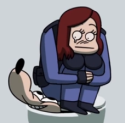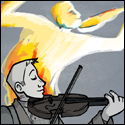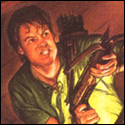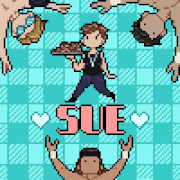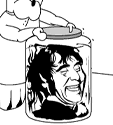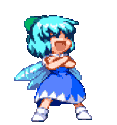|
A handful of pages back someone wanted the playtest packet with the Sorcerer in it. Here you go, page 11. This is the August 13th packet. http://www.speedyshare.com/6bJhv/081712-Classes.pdf Hypothetical question just for shits and giggles. Is there a way to make having a large "spells" chapter containing most/all actions a decent option? Rename it to the more neutral sounding but still loaded term "powers", give each class a power list, cut down on the chaff and streamline it a bit? Instead of casting Bull's Strength, maybe there's a generic "Improve Strength" power that's available to Clerics, Barbarians, etc. Maybe Clerics get a class ability to target others with an "Improve X" power, while Barbarians get the ability to use them as a bonus action or multiple at once. Monks could get the same "Deflect Projectile" power to emulate that 3.5 feat, while a Dragon could use that as an aura to emulate hurricane-force winds from their wings. Classes and monsters can have different riders or additions they can add to these powers, or perhaps different ways to regain use of their Not Spell Slots in fights. In short, combining both 4E and 3/5E's systems together.
|
|
|
|

|
| # ? May 30, 2024 21:26 |
|
Ederick posted:A handful of pages back someone wanted the playtest packet with the Sorcerer in it. Here you go, page 11. This is the August 13th packet. There was some of this in the last wave of 3.5 splatbooks, and it worked okay. The problem with genericising it completely, though, is: where is the distinction formed? If the only difference between a rogue's "powers" and a wizard's "powers" is that the wizard has access to more of them, then it hasn't really solved the problem. Your solution does potentially approach one of the cornerstones of the issue, though: Martial classes have access to precisely what is in the 4-5 pages of their class description, plus feats and equipment. Casting classes have access to 4-5 pages of class description, feats, equipment, the big-rear end spell list in the back half of the PHB, and also like 1/3 of every splatbook ever printed.
|
|
|
|
The Fighter in that playtest packet is so much better it's insane EDIT: Ederick posted:Hypothetical question just for shits and giggles. Is there a way to make having a large "spells" chapter containing most/all actions a decent option? Rename it to the more neutral sounding but still loaded term "powers", give each class a power list, cut down on the chaff and streamline it a bit? Instead of casting Bull's Strength, maybe there's a generic "Improve Strength" power that's available to Clerics, Barbarians, etc. Maybe Clerics get a class ability to target others with an "Improve X" power, while Barbarians get the ability to use them as a bonus action or multiple at once. Monks could get the same "Deflect Projectile" power to emulate that 3.5 feat, while a Dragon could use that as an aura to emulate hurricane-force winds from their wings. Classes and monsters can have different riders or additions they can add to these powers, or perhaps different ways to regain use of their Not Spell Slots in fights. In short, combining both 4E and 3/5E's systems together. The Battle Master sort of flirts with this: you need Superiority Dice to use your "maneuvers", and the maneuvers are not spells, and you only get so many Superiority Dice to play with until you need to regenerate them by taking a (short) rest. Except WOTC only made 20 maneuvers, and since the maneuver's functionality has to tie back to the roll of the die somehow it's almost always about dealing more damage* (or to something numerical like AC), and there's no "gating" mechanic so you just take the best maneuvers ASAP and then you're just picking from the dregs by your last tier of picks, also you can't have one maneuver be so much better than the others because again they're not gated. It's a cool idea, though one that I don't think D&D would adopt at this point. Ideally, while a Wizard can cast the Alarm spell, a Fighter should also be able to replicate its effects, and so should a Ranger, and so should a Barbarian, etc., by using their own respective resources. * I see from the packet that at some point the "Expertise dice" had maneuvers that would simply expend the die, freeing the designer from having to come up with something that would use the number on the die roll. gradenko_2000 fucked around with this message at 16:58 on Jan 15, 2015 |
|
|
|
Most wargaming in the last decade has adopted that model, and works excellently. The problem is that a LOT of RPG gamers (D&D players especially...) have zero imagination and want to be told exactly how to picture a magic missile or lightning bolt working. So an ability like Zap! is fine in Kings of War, but in D&D it's unacceptable because Call Lightning, Lightning Bolt, and Ball Lightning all need to be different things that work differently or else it's just "generic" and "samey."
|
|
|
|
Ederick posted:A handful of pages back someone wanted the playtest packet with the Sorcerer in it. Here you go, page 11. This is the August 13th packet. Thank you so much for posting this!
|
|
|
|
chaos rhames posted:I mean like "you get blasted by a fire elemental's lava piss, but now you can piss lava back". You'd have to gate it with something like not being able to go over your caster level, and it would probably end up being bloated with lots of insane abilities and encourage provoking monsters into pissing lava onto you and being the centre of attention, but it'd limit the insane breadth of spells and abilities that casters get and have some personality to it. The general problem with this is that monsters which have lava piss tend to be immune to lava piss, so having a lava pissing contest with them results in you burning to death and them being smelly. (I'm assuming here of course that lava piss smells) This isn't true of everything, of course, but having a character which relies on getting hit, absorbing the attack in some fashion, and then doing the same thing back is going to wind up with that character being fairly ineffectual, a lot of the time.
|
|
|
|
thespaceinvader posted:The general problem with this is that monsters which have lava piss tend to be immune to lava piss, so having a lava pissing contest with them results in you burning to death and them being smelly. Change it to Taskmaster powers - whenever they see it they learn how to do it.
|
|
|
|
If they had a limited selection of powers that they could choose when to replace, it might work - but it relies on PC and monster powers being broadly balanced, which they're not. I could see it being an interesting class if it was well designed but
|
|
|
|
CobiWann posted:Well yeah, they don't know where to place the Fireball spell. Turns out I've been casting lightning bolts for years but they've just been vanishing into the space between grid squares.
|
|
|
|
The Real Foogla posted:What's the rationale for targeting grid intersections instead of squares anyway? Just to make fireball patterns prettier?
|
|
|
|
The Real Foogla posted:What's the rationale for targeting grid intersections instead of squares anyway? Just to make fireball patterns prettier? Where in the square would you target? Where exactly do creatures stand within a square? The exact center? Can you move it slightly off? How are partially-covered squares counted? Based on the answers, a 5' radius spell could be ruled as targeting a single square, a + shape, a 2x2 square, or a 3x3 square. The caster probably wants whatever's more powerful/convenient, the DM might want whatever's more challenging, and everyone else at the table wants those two to stop arguing so they can take their goddamn turn already. Targeting on intersections removes most of these questions and allows for consistent rulings while still allowing spell descriptions to work for groups who use TotM. Unfortunately, while it makes sense, it's not very intuitive and really should have been explained in the rules. Something like this, maybe: "Choose the intersection of two lines on the grid as the origin for your spell. Each square with a corner on the origin point comprises the first 5 feet of the spell's radius. Following the 'movement on a grid' rules, the spell affects all squares that can be reached from any of these initial squares using the remaining radius as a movement speed." If you draw it out, you start getting some squares that should be hit but aren't (based on the 'at least half-covered by the circle' suggestion) once a spell's radius exceeds 10', but wizards could stand to lose some power anyway 
|
|
|
|
Slippery42 posted:Where in the square would you target? Where exactly do creatures stand within a square? The exact center? Can you move it slightly off? How are partially-covered squares counted? Based on the answers, a 5' radius spell could be ruled as targeting a single square, a + shape, a 2x2 square, or a 3x3 square. The caster probably wants whatever's more powerful/convenient, the DM might want whatever's more challenging, and everyone else at the table wants those two to stop arguing so they can take their goddamn turn already. Targeting on intersections removes most of these questions and allows for consistent rulings while still allowing spell descriptions to work for groups who use TotM. Unfortunately, while it makes sense, it's not very intuitive and really should have been explained in the rules. Something like this, maybe: I miss Bursts and Blasts.
|
|
|
|
After however many pages, I'n pretty aware of the strengths and weaknesses of Next, so I'm not really interested in hearing about the specific implementation of this in it. However, I'd like to hear why people who do like Theater of the Mind combat like it. Is there anyone who likes tactical combat who also likes TotM?
|
|
|
|
What I don't understand about the ruling is that, if you want to use grids in the first place it's pretty obvious you want to make some narrative compromises to make positioning clearer/more important. If you're the kind of person using the totally optional grid rules in the DMG why do you care if your fireballs are square or circular? Having square blasts in 4e was clear and fast. There as absolutely nothing ambiguous about who was in/not in a square in that system. I really, really don't want to have to break out a compass to draw a circle around the intersection just to figure out if some character at the edge is technically in a half-square or not. I can understand coming from 2e or 3e and looking at square blasts and thinking, "lol more like Firesquare" but you're probably not using the grid rules. Who are these rules even for? wallawallawingwang posted:After however many pages, I'n pretty aware of the strengths and weaknesses of Next, so I'm not really interested in hearing about the specific implementation of this in it. However, I'd like to hear why people who do like Theater of the Mind combat like it. Is there anyone who likes tactical combat who also likes TotM? EDIT: I use TotM in Shadowrun and WoD when I run those games and I prefer it because there's less transition time between narrative and combat. Combats in those games tend to run for 20 minutes or less, in my experience, so and are not a required part of those game's functionality, but I find there is more granularity in a given scene/session without the use of a grid. Grid pretty much means combat time or the expectation of combat time. It also represents significant prep time for the GM and forces a level of rigidity on an encounter, particularly if you take pains to make sure your encounters are interesting. That being said I think that grid combat should happen in games like DnD where the combat is supposed to be innately enjoyable and part of the flare. I think it's possible to do a game with some grid and some not-grid and just make sure you have a way of introducing each. Mendrian fucked around with this message at 00:32 on Jan 16, 2015 |
|
|
|
wallawallawingwang posted:After however many pages, I'n pretty aware of the strengths and weaknesses of Next, so I'm not really interested in hearing about the specific implementation of this in it. However, I'd like to hear why people who do like Theater of the Mind combat like it. Is there anyone who likes tactical combat who also likes TotM? Theater of the Mind is great in any game that is actually built for using it, which Next is not.
|
|
|
|
wallawallawingwang posted:After however many pages, I'n pretty aware of the strengths and weaknesses of Next, so I'm not really interested in hearing about the specific implementation of this in it. However, I'd like to hear why people who do like Theater of the Mind combat like it. Is there anyone who likes tactical combat who also likes TotM? Basically it's great if you handwave it as everyone being in "close enough to shitkick each other"-range, and you're not using any kinds of area attacks. Or else you just handwave those and say "yeah it hits all the badguys and no goodguys."
|
|
|
|
wallawallawingwang posted:After however many pages, I'n pretty aware of the strengths and weaknesses of Next, so I'm not really interested in hearing about the specific implementation of this in it. However, I'd like to hear why people who do like Theater of the Mind combat like it. Is there anyone who likes tactical combat who also likes TotM? I like grid combat for D&D, and I'm also a big fan of ToTM-type stuff in other games. I'm not sure how you want me to explain why I like ToTM in games that aren't Next without discussing the differences between those games' and Next's implementations of it, but I'll try. If I'm playing 4e, I draw a map of the area, and players interact with it by moving their miniatures around by the rules. "If I want to move these six squares towards the dude and use Tide of Iron to kick him down the chasm, I will have to move through an on-fire square or past this guy and take his OA to do so <uses appropriate rules>". Everyone can see the grid and the PCs and the chasm and the dude, so it's obvious what has to happen for the PC to make it to the dude and still attack. If I'm playing Dungeon World, then I describe the area. "There's a chasm here, and some tipped-over braziers scattered around" and players can interact with those by saying they do - "I charge across and kick the dude down the chasm" and then we can talk about what that means in terms of the PC exposing themselves to attack, or having to drop something, or taking damage running through the fallen coals from the brazier or whatever, then roll the dice. Both of those are good in their own way. The reason I like the second one is that it ends up flowing freely as a scene of a story - nobody's really stopping to count squares or figure out ranges, so it ends up being quicker and generally more cinematic. ToTM is fantastic as long as it's not asking me to just imagine a grid with minis on it (or, I guess, a scene where I'm supposed to remember everything's direction and distance from everything else to a tolerance of 5'). Elector_Nerdlingen fucked around with this message at 01:17 on Jan 16, 2015 |
|
|
|
AlphaDog posted:I like grid combat for D&D, and I'm also a big fan of ToTM-type stuff in other games. I'm not sure how you want me to explain why I like ToTM in games that aren't Next without discussing the differences between those games' and Next's implementations of it, but I'll try. I guess I phrased that badly. Sorry. It's more like I don't need to hear how Next is bad at TotM, but I'm perfectly happy to hear about it in comparison with other games and editions! I'm coming at this as a guy who likes tactical 4e style combat, but is pretty tired of: -The 5 foot step lambada that comes up whenever a ranged character gets approached by a monster, or when melee fighters slowly shuffle around trying to get into flanking. -Players figuring out their moves minesweeper style, trying to avoid attacks of opportunity. -The prep time of drawing out a map and the break in game play it causes. -The map scale making it a little harder to setup encounters where long distance matters. If I were going to fill out the pros and cons for grid combat I'd start there. I've got no idea what the pros and cons of TotM would be, aside from what has been mentioned just now.
|
|
|
|
wallawallawingwang posted:I guess I phrased that badly. Sorry. It's more like I don't need to hear how Next is bad at TotM, but I'm perfectly happy to hear about it in comparison with other games and editions! I sort of feel like your first two points are an inevitable consequence of grid combat. To a certain degree grid combat rewards optimal play since there is such a fine degree of control over movement and action opportunity. ToTM is: + Faster (usually, unless you're trying to replicate grid-level tactics in TotM) + Requires less prep + Allows characters to do whatever is the most dramatic right now instead of quibbling over relative distances + Is much easier to edit on the fly ("Anything to jump on? Uh sure... there's a cart over by this banner...") + Encourages interacting with the most interesting thing instead of the most optimal thing + Puts less play emphasis on combat + Granular transition between combat and non-combat However: - It makes tactical play slow or impossible - Can result in needless arguments over details when those details are suddenly relevant ("What do you mean you weren't next to Wayne? You handed him a potion last round!") - Makes certain character types useless or boring (rogues, I'm looking at you) - Makes range binary - Combat options are often simple or forgone; melee characters stand next to each other and press 'B' until dead; removes movement as a component of play - Makes things like cover confusing as gently caress
|
|
|
|
wallawallawingwang posted:I guess I phrased that badly. Sorry. It's more like I don't need to hear how Next is bad at TotM, but I'm perfectly happy to hear about it in comparison with other games and editions! I must have edited my previous post as you were replying, so it's probably closer to what you were after now. I'll try to sum up what I think about ToTM in general here: Pros: + significantly less prep time than making tactical maps +less fiddly to run, also faster + more freedom to describe actions (or, to put it differently, your actions are less constrained by the movement/range system) + narrative has a bigger effect (that is, how you are doing something tends to become more important than what you are doing) Cons: - primarily, can confuse the absolute poo poo out of people who aren't used to it - even those who are used to "in the ToTM imagine yourself 45' directly to the southwest of the enemy with a table 15' in front of you and a chasm 5' to the left". - can be more difficult to remember where stuff is than using a grid map* - the rules about what you can do tend to be less specific and more general (tying in with the last two points above) - can cause arguments about details *You can use a map and/or other visual aids with ToTM combat which will help with this problem. Obviously not a grid+minis, but there's no reason not to have a map divided into rough zones (where a move action gets you between zones) or a set of minis and tokens to indicate who's engaged in melee and who's at what range category.
|
|
|
|
Again, what on earth is the benefit of a grid over using a whiteboard and ruler with measurements in inches (like 1 inch = 10 feet or whatever works w/ regards to the minis).
|
|
|
|
mastershakeman posted:Again, what on earth is the benefit of a grid over using a whiteboard and ruler with measurements in inches (like 1 inch = 10 feet or whatever works w/ regards to the minis). It's much much easier to eyeball things on a grid. Also the table/board getting bumped won't accidentally put you slightly in/out of range of whatever. Elector_Nerdlingen fucked around with this message at 01:59 on Jan 16, 2015 |
|
|
|
mastershakeman posted:Again, what on earth is the benefit of a grid over using a whiteboard and ruler with measurements in inches (like 1 inch = 10 feet or whatever works w/ regards to the minis). This really only applies to D&D and D&D-alikes, but since decades of convention have make it so that maps are nearly always drawn on a grid it is a bit easier to replicate the map where the encounter is taking place on a grid than to draw it out freehand. Drawing a room as a 5x5 square on a grid is way easier than trying to draw a 5 inch by 5 inch square using a ruler.
|
|
|
|
mastershakeman posted:Again, what on earth is the benefit of a grid over using a whiteboard and ruler with measurements in inches (like 1 inch = 10 feet or whatever works w/ regards to the minis). Grids are abstractions that tell you exactly how things work. 4e is a game that has almost no ambiguity about how things move, about when something does or does not provoke an opportunity attack, exactly how large an effect is, and more. Take a fireball. In whiteboard land you have to actually draw the exact dimensions of the fireball to figure out if it hits something. In 4e I don't even need to draw the effect - just know the origin square and count outwards. Speed, frankly. If you're going to be concerned about the fiddly bits of exact placement you might as well just go ahead and use a grid. All a grid does it put concrete rules on the whiteboard space. I don't need to measure X inches to use a grid, or even a ruler. If you think about it a grid is just a whiteboard where somebody has already done the measurements for you.
|
|
|
|
I prefer the gridless combat from 13A - its like TotM except with visual aids and still no counting or measuring.
|
|
|
|
Gort posted:Turns out I've been casting lightning bolts for years but they've just been vanishing into the space between grid squares. Do what I do. Cast them on a diagonal.
|
|
|
|
Jackard posted:I prefer the gridless combat from 13A - its like TotM except with visual aids and still no counting or measuring. I like it as well but I've noticed that what is "nearby" and "far away" can get pretty muddled to the point where almost everything just gets considered "nearby" either to just avoid arguments or because the alternative is something that's really cool/necessary to avoid TPK doesn't happen.
|
|
|
|
Rannos22 posted:I like it as well but I've noticed that what is "nearby" and "far away" can get pretty muddled to the point where almost everything just gets considered "nearby" either to just avoid arguments or because the alternative is something that's really cool/necessary to avoid TPK doesn't happen.
|
|
|
|
Has anyone heard of anything like 4e's Drama Cards for 5e? I think they would spice up the game quite a bit.
|
|
|
|
Go gridless, but use legos for all your combat.
|
|
|
|
Gridless can be faster, if you're playing in a system that's designed for it. By that I mean one where there are abstractions and rules designed specifically to handle the fact that you don't really see exactly where everyone is: quote:TAAC does not use miniatures or a grid for combat. Part of the reason for this is to stay in keeping with the OG, which didn’t either, and the other part is that I find shuffling figures around a map, measuring distances and counting off how many squares a fireball affects to be hideously tedious. (But that’s just me.) Or 13th Age's system, or The Next Project, and so on. I hesitate to call D&D Next's combat as gridless, because all you're really doing is not using a grid. It's still there, you just don't see it, and it just so happens that the combat is simple enough that you can muddle through it, but all of the mechanics still assume that it's there. mastershakeman posted:Again, what on earth is the benefit of a grid over using a whiteboard and ruler with measurements in inches (like 1 inch = 10 feet or whatever works w/ regards to the minis). If I wanted to find out the distance between 2 minis, I'd need to break out a ruler and measure ... or I could just count the number of grid squares between them.
|
|
|
|
gradenko_2000 posted:If I wanted to find out the distance between 2 minis, I'd need to break out a ruler and measure ... or I could just count the number of grid squares between them. Counting squares is no easier than holding and reading a tape measure or ruler.
|
|
|
|
wallawallawingwang posted:After however many pages, I'n pretty aware of the strengths and weaknesses of Next, so I'm not really interested in hearing about the specific implementation of this in it. However, I'd like to hear why people who do like Theater of the Mind combat like it. Is there anyone who likes tactical combat who also likes TotM? I like both, so long as the system is made for it. Next is a grid-based game desperately trying to pretend it's not. TotM, a phrase I never even heard before Next started using it, needs abstractions, not exact measurements. Guess what Next uses? Rannos22 posted:I like it as well but I've noticed that what is "nearby" and "far away" can get pretty muddled to the point where almost everything just gets considered "nearby" either to just avoid arguments or because the alternative is something that's really cool/necessary to avoid TPK doesn't happen. I just use zones in areas large enough to have a "far away."
|
|
|
|
PeterWeller posted:Counting squares is no easier than holding and reading a tape measure or ruler. Squares are a ruler you never have to take out or adjust or argue about whether you nudged a little plastic man -- they are always there. So...I disagree. Using a ruler or tape measure is easy, but it's not identical to using a grid.
|
|
|
|
PeterWeller posted:Counting squares is no easier than holding and reading a tape measure or ruler. It's easier in the sense that I don't have to keep passing around a tape measure.every time someone wants to know if they can hit the goblin. Glancing at a grid map and mentally going "five squares, got it" is quicker and simpler than having to hand measure poo poo wargame style unless you can't count to six in your head I guess.
|
|
|
|
Eh, you guys are getting a bit ridiculous. People have short term memory and can eyeball approximate distances which will often be all you need. There's really no appreciable difference in a system that isn't built around using one method or the other.
|
|
|
|
PeterWeller posted:Eh, you guys are getting a bit ridiculous. People have short term memory and can eyeball approximate distances which will often be all you need. There's really no appreciable difference in a system that isn't built around using one method or the other. If by this you mean "can look at two minis on a table and be able to tell if they're 5, 6, or 7 inches apart and know the difference" then no, you're wrong.
|
|
|
|
P.d0t posted:If by this you mean "can look at two minis on a table and be able to tell if they're 5, 6, or 7 inches apart and know the difference" then no, you're wrong. How do you get "can tell exactly 5, 6, or 7 inches apart" from the word approximate? I meant, "can tell when something is clearly within or outside 6 inches and when it's so close it needs to be measured."
|
|
|
|
Which still sounds less simple than "X squares y/n?"
|
|
|
|

|
| # ? May 30, 2024 21:26 |
|
PeterWeller posted:How do you get "can tell exactly 5, 6, or 7 inches apart" from the word approximate? I meant, "can tell when something is clearly within or outside 6 inches and when it's so close it needs to be measured." As someone who doesnt use inches at all for any reason I would be pretty much unable to determine how far an inch is.
|
|
|









